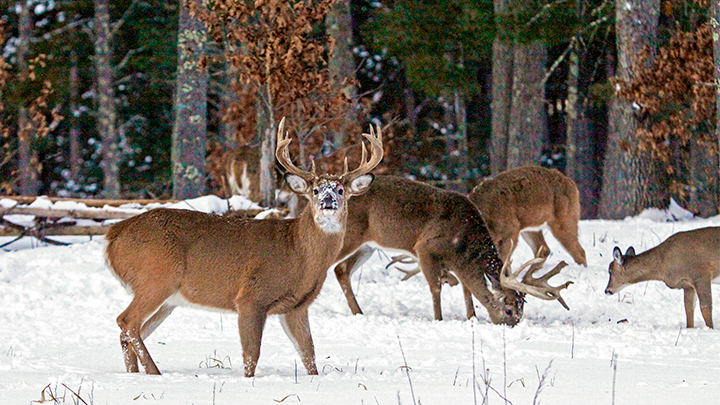
As whitetail seasons commence to close, your quarry has lived through three or more months of continual hunting pressure. What if whitetails have a shutout going on your hunting game? What is your gameplay when the two-minute warning sounds on the season? Consider a changeup to triumph in the closing hours.
Decoys, Scents and Calls
Despite a slowdown in the rut and bucks returning to underground life, males still have a spark to propagate the species if opportunity knocks. Be the knock of opportunity. By December in much of whitetail country, studies reveal the majority of does are bred with approximately 10 percent of the females possibly returning to estrus before Christmas. One doe emitting the scent of estrus captures the lusty attention of every buck within smellable distance.

To simulate that event, consider placing a doe decoy in your location along with a scent wick dipped in a doe-in-heat concoction such as Golden Estrus. Deer calls, grunts, bleats and rattling provide attention-grabbing auditory cues for upwind deer that miss the decoy advertisement.
Late-season hunts generally dictate the use of a doe decoy to represent a breeding opportunity, but you can team it with a buck for a holiday party portrayal.
Skip the Buffet
Bucks can easily shed up to 25 percent of their weight in the rut. When the available doe market decreases, bucks soon return their focus to food and rest. Does also return to a heavy feeding schedule with winter’s onset creating congestion on hot feeding areas like your food plot or a local agriculture field. Unfortunately, this creates overcrowding at these sites, making them nearly impossible to access due to herd security measures.
Instead of risking bumping deer at these sites, return to your October hunting strategy when bucks oftentimes disappear after the bachelor-group breakup period. Hunt them along travel corridors removed from food sources.
Fall back on your previous scouting supported by updated trail camera images to locate active trails bucks use on their way to food sources. Your encounters will likely be in thicker cover and earlier as bucks rise from bedding in a sanctuary to weave their way to a food source. The key is not to set up too close to refuge. New ground blinds should be brushed in completely and treestands set off the trail at least 15 yards or more to escape deer peripheral vision.
Weather Channel Junkie
There is a big debate fueled by new GPS research on what motivates deer to move. Many of the results show little correlation in weather changes stimulating deer movement. This is particularly true of Southern deer as opposed to Northern deer oftentimes in the fight of their life for late-season survival. That noted, extreme weather was the one exception. Be on the lookout for major weather changes including plummeting temperatures, extended storms and prolonged periods of precipitation be it snow or rain.

Barometric changes, revealed through quality forecasts, give you the jump on when you need to plan a hunt, especially in the Midwest and points north. Two to four hours before any storm you will likely see a surge in whitetail feeding if an extended weather event is about to unfold.
Deer also need to feed after the climax of the event. Although deer are accustomed to hunkering down in the winter to conserve energy regardless of the weather, when the storm breaks, expect again to see an increase in activity as deer seek calories to refuel. Monitoring these weather events with your hunting app and being in your stand prior to the event and after it is a solid strategy.
Sleep In, Sleep Over
You may not have an option to backtrack from a hotspot food source. Instead of avoiding it, simply skip the morning and hunt the afternoon. By skipping the morning, you allow nocturnal feeding deer to return to bedding cover uninterrupted at dawn. Before they return to the afternoon chow line, you settle into your ambush position for their dusk arrival.
The one hitch to this strategy is an exit. Masses of deer could trap you in a stand, and if you bump deer too many times, like on the morning-style hunt you skipped, it could change behavior.
First, consider setting up so you can silently exit your ambush site after dark and drop into a draw or gulch or behind a veil of vegetation for a downwind, hidden exit. Another option many of my hunting peers utilize is to simply wait until dark and have a partner slowly drive through the deer in a vehicle. Typically, deer in the dark bound away a short distance and return after the commotion subsides. A final option, for those of you hunting premier, enclosed blinds, is to merely sleep over and hunt the morning and afternoon.
Hunting whitetails late in the season requires a changeup from the benefits the rut provides. Add a new strategy to your playbook to get it across the goal before the game is over.




































